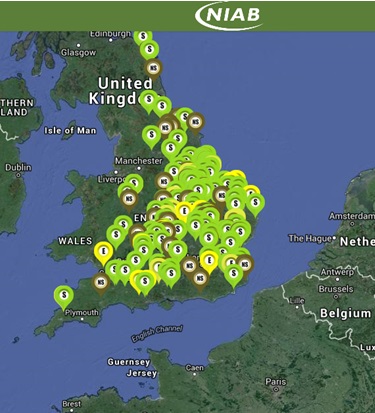This is continuing the theme of my previous blog. It summarised some of the very sensible and practical approaches that can be taken to reduce pesticide movement to water in order to meet the very demanding targets set by the Drinking Water Directive (DWD).
Research in France over the last twenty years and practical experience in the UK show that pesticide choice and dose is not such a significant issue in meeting the DWD standards when the soil profile is relatively dry at the time of application and there is no significant rain for at least a week or so following application. The issue of pesticide choice and dose becomes critical when the soil profile is close to soil moisture capacity at application, particularly if it rains within a few days after application. In France there are guidelines on pesticide choice and dose where the soil is relatively dry and where it is approaching soil moisture capacity. These guidelines make interesting reading, particularly because they are derived from field experimentation rather than modelling.
It is also interesting to note that in field trials in France there has been more pesticide movement to water in some Integrated Pesticide Management approaches, when compared to more conventional treatments. The explanation is obvious. The conventional treatments were applied when the soil profile was reasonably dry but the IPM treatments involved delayed autumn drilling and pesticide applications were made to a wetter soil profile. Although less pesticide was applied in the IPM treatments they resulted in more pesticide movement to water. This goes back to the dilemma of what we are trying to achieve with IPM, namely a reduction in pesticide use or a reduction in pesticide impact. This example demonstrates that reducing pesticide use does not necessarily mean reducing impact and I hope that our researchers have the nouse to aim for a reduction in impact rather than use.
There are some situations in the UK where there can be a very real conflict between optimising pesticide performance and reducing pesticide movement to water. The clearest example was covered in the previous blog. Propyzamide is an essential element in black-grass control in autumn sown oilseed rape and it has to be applied to wet and cold soils to optimise control. Subsequent rain can mean huge (in terms of the DWD) spikes in propyzamide levels in the water courses feeding water works although such levels comply with the Environmental Quality Standards. Whilst buffer strips, particularly in high risk fields, will reduce surface run-off, the movement through the soil to field drains can alone cause spikes.
It is absolutely essential to reduce the size and number of these spikes which can result in the closure of water works until the content supplied to domestic users meets the DWD standard. It seems to me, and this is not an original thought, that a way out is to try to close off the intake of the water works during the few hours when the spike occurs in addition to the other stewardship guidelines issued by the pesticide and water companies and the Voluntary Initiative. This is more difficult than it seems. First of all the water company has to be able to shut off the intake i.e. be able to supply water from another source or have reservoir storage it can utilise whilst the intake is off. Unfortunately, these facilities are not available at all water treatment works. The water company then needs to know when and where the propyzamide is sprayed and then it has to calculate the travel time of the spike to the intake of the water works.
The latter is getting more possible with more understanding of pesticide movement to water but locating when and where propyzamide is applied remains a difficult issue for water companies. Perhaps help is at hand with so-called ‘crowd-sourcing’ software on mobile phones. NIAB TAG is pioneering such an approach in order to improve further the services to its farmer subscribers. It was first tried last April by asking farmers the stage of flowering of their oilseed rape in order to improve the prediction of sclerotinia risk. Each farmer’s response was automatically geo-referenced and within a few hours the map in this article was achieved. NIAB TAG is rolling out other uses for this approach and it is envisaged that the information provided can only result in more precise and timely advice.
Whilst I realise that NIAB TAG members have a common cause for taking part in crowd-sourcing approaches, I would suggest that farmers in the relevant catchments have every reason for working with water companies in a similar way in order to reduce the problem of spikes of pesticide content in the raw water entering water works.

IT can also help by providing improved field specific advice. The WaterAware app. from Adama is an encouraging start but its designers accept that improvements are needed. Nevertheless, it gives the platform for the farmer or adviser to assess the risk of pesticide movement to water on a field by field basis through geo-referenced information on soil type and weather. Such an approach will still need the expertise of the farmer or adviser in order to make final decisions but it should lead to an improvement in decision making.
